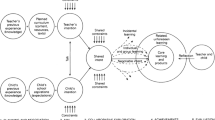Abstract
This study examines 1) how Korean elementary teachers implement curriculum integration in their teaching practice and 2) what Korean elementary teachers experience in implementing curriculum integration. Several issues evolved from the analysis of three teachers ’ experiences: firstly, the teachers ’ lack of theoretical frameworks for curriculum integration, secondly, the teachers ’ pragmatic approach to curriculum integration, and thirdly, the limitations on implementing curriculum integration. In order for curriculum integration to be properly implemented and sustained, teachers ’ roles in and understanding of the curricula are crucial. Thus, the implications of the findings are discussed in terms of teacher preparation and training.
Similar content being viewed by others
References
Arcavi, A., & Schoenfeld, A. H. (1992). Mathematics tutoring through a constructivist lens: The challenges of sense-making.Journal of Mathematical Behavior, 11(4), 321–335.
Bodner, G. M. (1986) Constructivism: A theory of knowledge.Journal of Chemical Education, 63(10), 873–878.
Cho, Y., & Kim, K. (1996). The construction of theme-based curriculum integration.The Korean Journal of Educational Research, 34(1), 251–272.
Caine, R., & Caine, G. (1991). Reinventing schools through brain-based learning.Educational Leadership, 52(7), 43–45.
Deal, T. E., & Kennedy, A. A. (1982).Corporate cultures. MA: Addison Wesley.
Dewey, J. (1902).The child and the curriculum. Chicago: University of Chicago Press.
Downe-Wamboldt, B. (1992). Content analysis: Method, applications, and issues.Health Care for Women International, 13(3), 313–321.
Drake, S. M. (1998).Creating integrated curriculum: Proven ways to increase student learning. Thousand Oaks, CA: Corwin Press.
Ellis, A. K., & Fouts, J.F. (2001) Interdisciplinary curriculum: The research base.Music Educators Journal, 87(5), 22–26.
Fogarty, R. (1991). Ten ways to integrate curriculum.Educational Leadership, 49(2), 61–65.
Gardner, H., & Boix-Mansilla, V. (1994). Teaching for understanding in the discipline and beyond.Teachers College Record, 96, 125–140.
Gehrke, N. J. (1991). Exploration of teachers ’ development of integrative curriculum.Journal of Curriculum Studies, 23(6), 107–117.
Goodson, I. F., & Marsh, C. J. (1996).Studying school subjects: A guide. London: Falmer Press.
Gutek, G. (2004).Philosophical and ideological voices in education. Boston: Pearson Education.
Hargreaves, A., Earl, L., & Ryan, J. (1996).Schooling for change: Reinventing education for early adolescents. London: Falmer Press.
Hargreaves, A., & Moore, S. (2000). Curriculum integration and classroom relevance: A study of teachers ’ practice.Journal of Curriculum and Supervision, 15(2), 89–112.
Harris, K. R., & Alexander, P. A. (1998). Integrated, constructivist education: Challenge and reality.Educational Psychology Review, 10(2), 115–127.
Hong, Y. (2006). A case study on elementary teachers ’ curriculum integration.Anthropology of Education, 9(2), 167–188.
Huntley, M. A. (1999). Theoretical and empirical investigations of integrated mathematics and science education in the middle grades with implications for teacher education.Journal of Teacher Education, 50(1), 57–67.
Hwang, Y. (1998). A recent trend of educational research for curriculum integration.The Journal of Chunnam Education, 92, 91–100.
Jeong, K. (2006). A narrative inquiry into implementation of integrated textbooks based on Korean elementary teachers.The Korean Journal of Curriculum Studies, 24(3), 125–146.
Kaufman, D., & Brooks, J. (1996). Interdisciplinary collaboration in teacher education: A constructivist approach.TESOL Quarterly, 30, 231–251.
Kim, D. (1996). A model for developing integrated curriculum at the school level.The Korean Journal of Curriculum Studies, 14(3), 18–40.
Kim, J. (1992). The necessity and validity of curriculum integration.The Journal of Education Development, 14, 92–103.
Kvale, S. (1996).Interview: An introduction to qualitative research interviewing. Thousand Oaks, CA: Sage Publication.
Lee, Y. (2001).Curriculum integration. Seoul, Korea: Hakjisa.
Lincoln, Y., & Guba, E. (1985).Naturalistic inquiry. Beverly Hills, CA: Sage Publication.
Mansilla, V. B., Miller, W. C., & Gardner, H. (2000). On disciplinary lenses and interdisciplinary work. In S. Wineburg & P. Grossman (Eds.),Interdisciplinary curriculum: Challenges to implementation (pp. 17–38). New York: Teachers College Press.
Miles, M. B., & Huberman, A. M. (1994).Qualitative data analysis (2nd ed.). Thousand Oaks, CA: Sage publication.
Mishler, E. G. (1986).Research interviewing-Context and narrative. Cambridge, MA: Harvard University Press.
Morgan, D. L. (1993). Qualitative content analysis: A guide to paths not taken.Qualitative Health Research, 3(1), 112–121.
Na, J. (2004). Elementary school teachers ’ understandings on curriculum integration.The Korean Journal of Curriculum Studies, 22(1), 101–124.
Panaritis, P. (1995). Beyond brainstorming: Planning a successful interdisciplinary program.Phi Delta Kappan, 86(8), 623–628.
Park, H. (2007). A narrative inquiry into what school culture makes it difficult to implement curriculum integration: A beginning teacher ’s experience.Anthropology of Education, 10(1), 63–88.
Richards, J. C., & Shea, K. T. (2006). Moving from separate subject to interdisciplinary teaching: The complexity of change in a preservice teacher K-1 early field experience.The Qualitative Report, 11(1), 1–19.
Tobin, K., & Tippins, D. (1993). Constructivism as a referent for teaching and learning. In K. G. Tobin (Ed.),The practice of constructivism in science education (pp. 3–21). Washington: AAAS Press.
Tylack, D., & Tobin, W. (1994). The grammar of schooling: Why has it been so hard to change?American Educational Research Journal, 31(3), 453–480.
Venville, G., Wallace, J., Rennie, L., & Malone, J. (1999).Science, mathematics, and technology: Case studies of integrated teaching. Perth, WA: Curtin University of Technology.
Author information
Authors and Affiliations
Corresponding author
Rights and permissions
About this article
Cite this article
Park, M. Implementing curriculum integration: The experiences of Korean elementary teachers. Asia Pacific Educ. Rev. 9, 308–319 (2008). https://doi.org/10.1007/BF03026719
Received:
Revised:
Accepted:
Issue Date:
DOI: https://doi.org/10.1007/BF03026719




